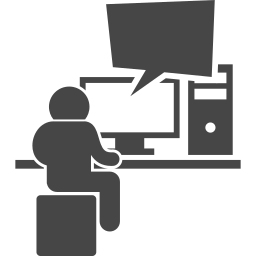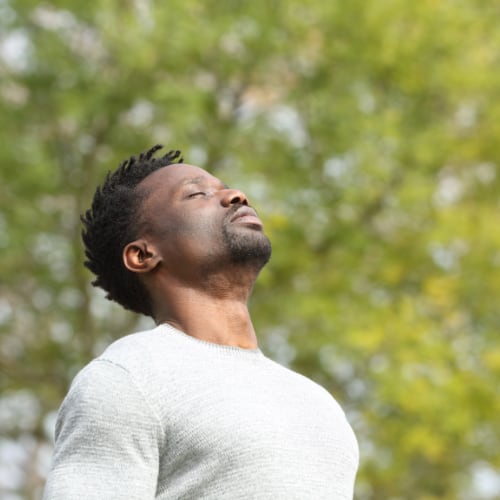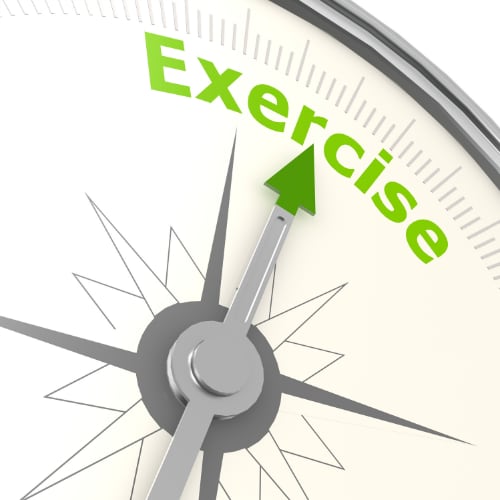 Deep Breathing
Deep Breathing
Deep Breathing

-
Main Ideas
Learning Objective
Understand the benefits and science behind deep breathing techniques to improve overall physical and mental health.
Behavioral Objective
Develop the ability to incorporate regular deep breathing exercises into daily life to manage stress and support well-being.
Key Thought
Deep breathing can activate the body's natural relaxation response, reduce chronic stress, and improve both mental and physical health.
-
Main Ideas
Learning Objective
Understand the benefits and science behind deep breathing techniques to improve overall physical and mental health.
Behavioral Objective
Develop the ability to incorporate regular deep breathing exercises into daily life to manage stress and support well-being.
Key Thought
Deep breathing can activate the body's natural relaxation response, reduce chronic stress, and improve both mental and physical health.
-
Terms
- Alternate Nostril Breathing
noun
A controlled breathing technique that involves alternating the flow of air between the left and right nostrils to engage the parasympathetic nervous system and promote relaxation.
- Autonomic Nervous System
noun
A part of the nervous system that controls involuntary bodily functions, including heart rate, digestion, and respiratory rate. It has two branches: 'fight or flight' (sympathetic) and 'rest and relax' (parasympathetic).
- Diaphragm
noun
A large, dome-shaped muscle located at the base of the lungs, responsible for controlling the process of inhalation and exhalation.
- Muscle Plasticity
noun
The ability of muscle to adapt and change in response to varying levels of activity, becoming stronger or more efficient depending on the demands placed on it.
- Victorious Breathing
noun
A deep breathing technique that involves creating resistance in the back of the throat to slow the breath, often producing an audible sound. Also known as Darth Vader Breathing.
-
Terms
- Alternate Nostril Breathing
noun
A controlled breathing technique that involves alternating the flow of air between the left and right nostrils to engage the parasympathetic nervous system and promote relaxation.
- Autonomic Nervous System
noun
A part of the nervous system that controls involuntary bodily functions, including heart rate, digestion, and respiratory rate. It has two branches: 'fight or flight' (sympathetic) and 'rest and relax' (parasympathetic).
- Diaphragm
noun
A large, dome-shaped muscle located at the base of the lungs, responsible for controlling the process of inhalation and exhalation.
- Muscle Plasticity
noun
The ability of muscle to adapt and change in response to varying levels of activity, becoming stronger or more efficient depending on the demands placed on it.
- Victorious Breathing
noun
A deep breathing technique that involves creating resistance in the back of the throat to slow the breath, often producing an audible sound. Also known as Darth Vader Breathing.
Introduction
Deep breathing is more than just a simple relaxation tool; it's a powerful way to improve physical and mental health. This practice leverages the body's natural processes to reduce stress, lower blood pressure, enhance lung capacity, and boost emotional well-being. By taking conscious control of your breath, you can engage the "rest and relax" system in the body, helping to counter the chronic stress many experience in modern life. Learning and practicing deep breathing techniques can offer tangible health benefits, making it a vital part of any wellness routine.
The Diaphragm Muscle
Muscles can change in various ways; they can grow in mass like the bodybuilder's muscle due to heavy loads for a short period or adapt in efficiency to be used for long periods under low stress, such as running. This adaptability is called muscle plasticity, and it's the body's way of meeting its demands.
Muscle plasticity works in the opposite direction too. Since muscle tissue is expensive for the body to maintain and repair, muscles that aren't challenged will diminish in size and efficiency, resulting in muscle loss or muscle atrophy.1
One set of muscles that are used frequently is the respiratory system's muscles. Researchers estimate that finger muscles are used about 2% of the time, calf muscles about 15%, and respiratory muscles like the diaphragm-which controls our breath-are used about 40% of the time. Managing and maintaining healthy respiratory muscles is a top priority for overall health.
The Uniqueness of Respiratory Muscle
Like other muscles, the respiratory muscles display a dynamic range of activity. They can handle slow, steady breaths, huge gasping breaths for intense exercise, or short, percussive exhales when singing. Unlike other muscles, however, respiratory muscles function both voluntarily and automatically. While we can control our breath when we want to, such as during exercise or singing, breathing happens automatically-when we read a book or sleep, for example.This involuntary breathing is controlled by sensors in the brain that measure oxygen, carbon dioxide, and acid-base balance in the blood.2 The brain adjusts our breathing automatically, similar to how the heart beats or food gets digested without conscious thought. When we speak, shout, sing, or play an instrument, we override the automatic system with the voluntary control of our breath.
The Science of Conscious Breath
The autonomic nervous system, responsible for non-conscious bodily functions, has a 'gas pedal' and a 'brake' that leave the body in either a heightened 'fight or flight' state or a calmer 'rest and relax' state. Many people today experience chronic stress, spending too much time in 'fight or flight' mode. This can contribute to various chronic disorders, both physical-like heart disease and high blood pressure-and mental, such as depression and anxiety.3
Controlled breathing exercises have been studied to engage the 'rest and relax' part of the nervous system, reducing chronic stress. Studies show that short bouts of deep breathing can immediately impact heart rate-a key indicator of stress and a 'fight or flight' response.4 Over time, regular practice of deep breathing can shift the body towards a calmer, more relaxed state, leading to improved mental and physical health.
Control of Breath, Control of Stress
Many people are unfamiliar with deep breathing techniques, even though they have existed for thousands of years and are well-researched for their health benefits. Here are two common deep breathing methods that engage the 'rest and relax' response, countering chronic stress in mind and body.3, 4
Victorious Breathing Technique (Darth Vader Breathing)
This technique creates intentional resistance in the back of the throat to slow down the breath. It is called 'Victorious Breathing' because it promotes deep, controlled breathing that lengthens the breath cycle. Many discover they can mimic this technique by pretending to sound like Darth Vader, using a constriction at the back of the throat to produce an audible inhale and exhale. Over time, this practice can reduce the breathing rate from 12-20 breaths per minute to as few as 2-4 breaths per minute.
The directions for victorious breathing include:
-
Find a Comfortable Position:
- Sit down in a relaxed position, either cross-legged or on a chair with your feet flat on the floor.
- Keep your spine straight, shoulders relaxed, and close your eyes.
-
Inhale Through Your Nose:
- Take a slow, deep breath in through your nose.
- Slightly constrict the back of your throat as you inhale, like you are fogging up a mirror with your mouth closed. This creates a subtle "ha" sound.
-
Exhale Through Your Nose:
- Keep the slight constriction in the back of your throat and slowly exhale through your nose.
- Aim to make the exhale sound similar to your inhale, creating a consistent "whispering" or ocean-like noise.
-
Keep Your Breath Even:
- Focus on inhaling and exhaling about the same length.
- You can try counting to 4 or 5 on both the inhale and exhale to keep the rhythm steady.
- Breathe deeply and evenly without straining.
-
Maintain the Throat Constriction:
- The key is the gentle constriction in the throat. Keep your face and jaw relaxed, only engaging the back of the throat.
- Imagine the breath coming from the base of your throat, and try to maintain a smooth, controlled flow.
-
Repeat and Focus:
- Continue this breathing pattern for several minutes, focusing on the sound and sensation of your breath.
- Let the sound guide you into a meditative state, calming your mind and centering your thoughts.
Tips:
- Getting the throat constriction right without causing tension might take a little practice.
- Keep your breath steady and avoid making the sound too harsh; it should be a gentle "wave" in the back of your throat.
- This breathing technique can be used during yoga poses or meditation to maintain focus and rhythm.
Alternate Nostril Breathing
This method requires alternating airflow between the left and right nostrils. It keeps you focused on the act of breathing, preventing distractions, and engaging the parasympathetic nervous system.
The directions for alternate nostril breathing include:
-
Sit in a Comfortable Position:
- Find a comfortable seat, either cross-legged on the floor or sitting in a chair with your feet flat.
- Keep your spine straight, shoulders relaxed, and close your eyes.
-
Prepare Your Hand Position:
- Use your right hand. Fold your index and middle fingers into your palm, leaving your thumb, ring finger, and pinky extended.
- The thumb will be used to close the right nostril, and the ring finger will be used to close the left nostril.
-
Close the Right Nostril and Inhale:
- Close your right nostril with your thumb.
- Inhale slowly and deeply through your left nostril.
-
Close the Left Nostril and Exhale:
- Close your left nostril with your ring finger as you release the thumb from your right nostril.
- Exhale slowly and completely through your right nostril.
-
Inhale Through the Right Nostril:
- Keeping the left nostril closed, inhale slowly and deeply through your right nostril.
-
Switch and Exhale Through the Left Nostril:
- Close your right nostril with your thumb again and release your ring finger from the left nostril.
- Exhale slowly and completely through your left nostril.
-
Repeat the Cycle:
- This completes one full cycle. Repeat the pattern, alternating nostrils for 5-10 minutes or as needed.
Tips:
- Always start and end with an exhale through the left nostril.
- Keep your breath slow, deep, and controlled. Do not force your breath.
- This technique balances the mind, calms the nervous system, and promotes relaxation.
Regular practice of these deep breathing techniques for just ten minutes daily can offer benefits to both physical conditions, such as heart disease and blood pressure, and mental health conditions, like anxiety and depression.
Citations:
1 Gransee, H. M., Mantilla, C. B., & Sieck, G. C. (2012). Respiratory Muscle Plasticity. In D. M. Pollack (Ed.), Comprehensive Physiology. Online: Wylie. Retrieved March 31, 2014, from http://onlinelibrary.wiley.com/book/10.1002/cphy/homepage/EditorsContributors.html
2 Lieberman, D. E. (2013). The Story of the Human Body: Evolution, Health and Disease. New York City: Pantheon Books.
3 Novotny, S., & Kravitz, L. (n.d.). The Science of Breathing. University of New Mexico Len Kravits Home Page. Retrieved March 31, 2014, from http://www.unm.edu/~lkravitz/Article%20folder/Breathing.html
4 Turankar, A. V., Jain, S., Patel, S. B., Sinha, S. R., Joshi, A. D., Vallish, B. N., & Mane, P. R. (2013, May). The Indian Journal of Medical Research, 137(5). Retrieved March 31, 2014, from http://www.ncbi.nlm.nih.gov/pmc/articles/PMC3734683/
Learn the Basics of Deep Breathing
Objective: Understand the importance of deep breathing techniques and how they impact the autonomic nervous system.
Activity:
- Read about the autonomic nervous system and how it influences stress and relaxation.
- Research the benefits of engaging the "rest and relax" response through conscious breathing.
- Practice deep breathing for 5 minutes, focusing on slow, steady inhales and exhales.
Practice Victorious Breathing
Objective: Learn and practice the Victorious Breathing technique to slow down breathing and activate relaxation.
Activity:
- Sit in a comfortable position with a straight back.
- Begin with normal breaths and then shift to constricting the back of the throat slightly, making a soft audible sound as you breathe.
- Inhale and exhale deeply for 2 minutes, gradually working towards longer inhales and exhales.
- Try to reach a rhythm of 2 to 4 breaths per minute over time.
Explore Alternate Nostril Breathing
Objective: Experiment with Alternate Nostril Breathing to enhance focus and engage the parasympathetic nervous system.
Activity:
- Sit comfortably with a straight back and relaxed shoulders.
- Use your right thumb to close your right nostril, exhale completely through the left nostril, and then inhale through the left nostril.
- Close your left nostril with the ring finger, exhale through the right nostril, and then inhale back through the same nostril.
- Alternate for 5 minutes, focusing on a slow and steady rhythm of breathing.
Course Outline
![]() Session Expired from Inactivity
Session Expired from Inactivity
Do you want to?
9618 Jefferson Highway, Suite D-191
Baton Rouge LA 70809-9636
(888) 424-0032 |
support@supplementrelief.com
* Disclaimer: This page is available exclusively for SupplementRelief.com clients. None of the information on this website is intended to replace your relationship with your healthcare provider(s). Nothing should be considered medical advice. The information, knowledge, and experience shared on this website are the opinions of SupplementRelief.com. This site and its content are intended to enhance your knowledge base as YOU MAKE YOUR OWN HEALTHCARE DECISIONS in partnership with your qualified health professional.
* These statements have not been evaluated by the Food and Drug Administration. These products and services are not intended to diagnose, treat, cure, or prevent disease.
* There is NO GUARANTEE OF SPECIFIC RESULTS for the products or services offered, and the RESULTS CAN VARY for each individual. Any results claimed by our customers are based on individual experiences that are unique and cannot be guaranteed.
FirstFitness Nutrition and NuMedica may be promoted and sold on the internet ONLY by Authorized Resellers who have been approved by and have registered their website domain with these companies. They strictly prohibit, and actively monitor, the UNAUTHORIZED SALE or RESALE of their products in ALL online public shopping portals including Amazon, eBay, and others and into other countries. All products purchased in SupplementRelief.com are for PERSONAL USE ONLY and CANNOT BE RESOLD to others. Please report violations of Reseller Policy directly to FirstFitness Nutrition at 800.621.4348 and to NuMedica at 800.869.8100.
The content and photographs on this website are copyrighted or Licensed Material and may not be downloaded for other than personal use. Republication, retransmission, reproduction, or any other use of the content or photographs is prohibited. ©2010-2024 SupplementRelief.com.
Are you sure you want to remove this item?





